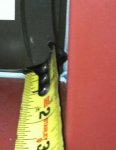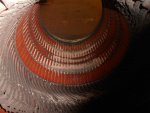K8MHZ
Senior Member
- Occupation
- Electrician
Let's say we wire a house and it is done perfectly, passes code and all, and a few years later a paint slinger comes in and paints over all the receptacle and switch covers with thick paint. The only way to get the covers off is to dig the screw slots out and cut and pry off the covers which have so much paint on them to do so would damage dry wall and wall paint.
I have seen the above after several painters have done their craft. Some so bad it took, even after scoring the paint (uh, also known as damaging the finish) it still took a hammer and chisel just to break the covers free, which caused damage to the drywall.
Have the painters committed an NEC violation? NO WAY would I consider anything that has to be chiseled off to be accessible.
Would any electrical inspector have the authority to force the home owner to replace all the covers? What about the switches where the 'ON' and 'OFF' were obliterated by the painters? Does an electrical inspector have the authority to require the HO to have those switches replaced?
Is not the above a violation in the same sense the situation the OP is describing?
As an electrician, I really wish it were. BUT.....I have NEVER once seen anyone that painted over a cover and stuck it to the wall get gigged for that. I agree, the siders put the screws to the electricians and the owner, but so do painters and carpenters. The concern seems to only be what the electrician did at the time of installation.
There must be some reason for that.
Once we can figure out that reason and eliminate it, we can get everyone cited for the finishing trades making our work inaccessible. The inspectors could also make the homeowners move the shelves, desks, dryers, etc. from in front of their service panels so we don't have to try to work over them while doing service to the panel.
I have seen the above after several painters have done their craft. Some so bad it took, even after scoring the paint (uh, also known as damaging the finish) it still took a hammer and chisel just to break the covers free, which caused damage to the drywall.
Have the painters committed an NEC violation? NO WAY would I consider anything that has to be chiseled off to be accessible.
Would any electrical inspector have the authority to force the home owner to replace all the covers? What about the switches where the 'ON' and 'OFF' were obliterated by the painters? Does an electrical inspector have the authority to require the HO to have those switches replaced?
Is not the above a violation in the same sense the situation the OP is describing?
As an electrician, I really wish it were. BUT.....I have NEVER once seen anyone that painted over a cover and stuck it to the wall get gigged for that. I agree, the siders put the screws to the electricians and the owner, but so do painters and carpenters. The concern seems to only be what the electrician did at the time of installation.
There must be some reason for that.
Once we can figure out that reason and eliminate it, we can get everyone cited for the finishing trades making our work inaccessible. The inspectors could also make the homeowners move the shelves, desks, dryers, etc. from in front of their service panels so we don't have to try to work over them while doing service to the panel.



